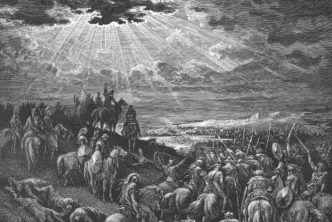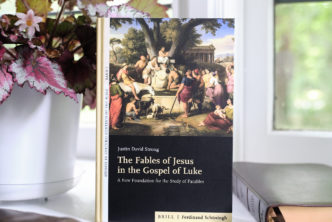Book Review
Paula Gooder, IVP Academic, 2018. 316 pp.
Review by Reta Finger.
I commend to you our sister Phoebe, a deacon of the church at Cenchreae, so that you my welcome her in the Lord as is fitting for the saints, and help her in whatever she may require from you, for she has been a benefactor of many and of myself as well. Romans 16:1-2.
It was not until the early 1980s, as the “new perspective on Paul” was developing, that scholars paid much attention to Phoebe and the other 28 names mentioned in Romans 16. Since then, Pauline scholars have used these names, along with additional socio-cultural and historical data, to reconstruct the events that would have caused Paul to write this lengthy theological letter from his location at Corinth to Jesus-believers in Rome, a city Paul had not yet visited. It is now generally accepted that Paul sent Phoebe, his highly-praised co-worker from Corinth’s port city of Cenchreae, to Rome bearing his letter and charged with having it read in all the house churches of Rome.
But Dr. Paula Gooder, a British writer and lecturer in biblical studies, wants to bring the Bible to life even more for contemporary readers. To this end, she builds on the latest scholarship to imagine what happened after the letter arrived and was read. Gooder’s narrative weaves together Phoebe’s life story with her relationships primarily within the house church led by Prisca and Aquila (Rom. 16:3-5). Besides this couple, whom Paul first met in Corinth (Acts 18:1-2), we meet Mary (Rom. 16:6), the apostles Junia and Andronicus (v. 7), Aristobulus (v. 10), Herodion (v. 11), “my beloved Stachys (v. 9), and other fictional characters with Latin, Greek, or Jewish names appropriate for that time and place.
Careful readers of Romans know that, though primarily theological, the letter also includes Paul’s future plans to visit Rome and, from there, take the gospel to Spain (15:22-32). Written some years later, Acts 21-28 recounts a different outcome, but Phoebe and the Roman believers know nothing of that future. They gather supplies for Paul’s mission to Spain and anticipate him coming within a month or two.
But the story centers on Phoebe herself. As she converses with Prisca and Aquila in their tentmaking shop, along with Junia and Andronicus, we learn that Phoebe also has a personal reason to visit Rome.
I must confess that, almost from the beginning, my skeptical antennae were out. In 1991, I had begun a doctoral program with Pauline scholar Robert Jewett, who had introduced me to the New Perspective on Romans, adding his own contributions to Phoebe’s story, Paul’s Spanish mission, and the character of the five house churches suggested in Romans 16. I had continued my research, which produced a book providing background for a sustained role-play of these house churches and their reactions to Paul’s letter. I had generally accepted Jewett’s characterization of Phoebe as a noblewoman, patron to Paul, and perhaps even running a shipping company at the port of Cenchreae.
Gooder’s Phoebe is indeed wealthy, but Gooder probes beneath the surface to find a woman torn with deep, unresolved pain and guilt going back to her childhood growing up in Rome. She has come to deal with these issues, as well as bringing Paul’s letter and helping to prepare for his mission to Spain. Each of the two couples—Prisca and Aquila, Junia and Andronicus—express their own very human personalities. Somehow, their conversation sounded a bit too psychological and contemporary.
I had read nearly 100 pages before realizing that the second half of the book contained Gooder’s extensive background notes undergirding her engaging plot. Notes for nearly every chapter explain different aspects of ancient Roman life, such as slavery, meals, infant exposure, patronage, the history of Jews in Rome, and hundreds of other details. Recognizing almost all of Gooder’s scholarly sources (including Jewett!), here I was on familiar ground. She has indeed integrated the research of many current Pauline scholars into Phoebe’s story so that its context in first-century Rome rings true to what we can know today.
Another feature of Phoebe’s story involves the way these early believers absorb the teachings and stories of Jesus either through what they have heard before from Jewish believers, from Paul’s previous letters or sermons, or from the letter Paul has just sent. This material is used to help believers deal with their own issues, such as the Roman nobleman who wants a private baptism so his acquaintances won’t know he is a Christian. It is a good reminder that these early believers were hearing and learning bit by bit what is now gathered into one canonical book.
My one disappointment was the lack of serious debate among these characters about the Romans letter itself. If Paul wanted the Roman believers to “send him on his way to Spain” (Rom. 15:24), he was equally concerned about a major obstacle towards that goal: lack of unity between the law-observant Jewish believers and their Gentile counterparts who viewed Mosaic law as irrelevant. Only Herodion made a fuss about Jewish law, and he was tolerated but often ignored. I recognize that the story of Phoebe, a Gentile, controlled the plot, and her struggles were not directly related to this issue. Nevertheless, if Paul was correct about tensions between Jews and Gentiles in the early churches, it seems like a rather large lacuna in the story.
There are a few other loose ends, but Phoebe: A Story kept me reading to the very end. I will not spoil the plot for other readers—but just say that Phoebe’s connections to Prisca and Aquila’s house church helped her resolve past issues in her life and provide an exciting challenge for her future.
Current readers of Paula Gooder’s story will, like me, cross historical boundaries to receive the gift of friendship with Christian believers much like us—but from the very dawn of our faith.
Reta Finger, a retired New Testament professor, writes a Bible study blog at www.eewc.com, the website of Christian Feminism Today. Her book referred to above is Roman House Churches for Today (Eerdmans, 2007, 2nd ed.).



